Masks in Mardi Gras are powerful symbols of freedom and creativity. They allow you to escape your everyday identity, promoting social mixing and interaction among diverse groups. Originally rooted in ancient traditions, these masks encourage a sense of unity while also showcasing individual artistry through vibrant colors and designs. Each color carries its own meaning—purple signifies justice, green represents faith, and gold embodies aspiration. Wearing a mask not only fosters anonymity but also celebrates cultural heritage, community engagement, and spiritual expression. If you're curious about how these elements intertwine, there's much more to explore.
Key Takeaways
- Masks symbolize freedom from everyday identities, allowing individuals to embrace new personas during Mardi Gras celebrations.
- Vibrant colors and intricate designs reflect cultural heritage, enhancing community bonding and shared festive experiences.
- Masks promote social mixing by breaking down class barriers and encouraging interactions across diverse social groups.
- Anonymity provided by masks fosters creative expression and community unity, reinforcing connections among participants.
- Masks are deeply intertwined with spiritual beliefs, facilitating cultural rituals and emotional healing within the community.
Historical Origins of Mardi Gras Masks
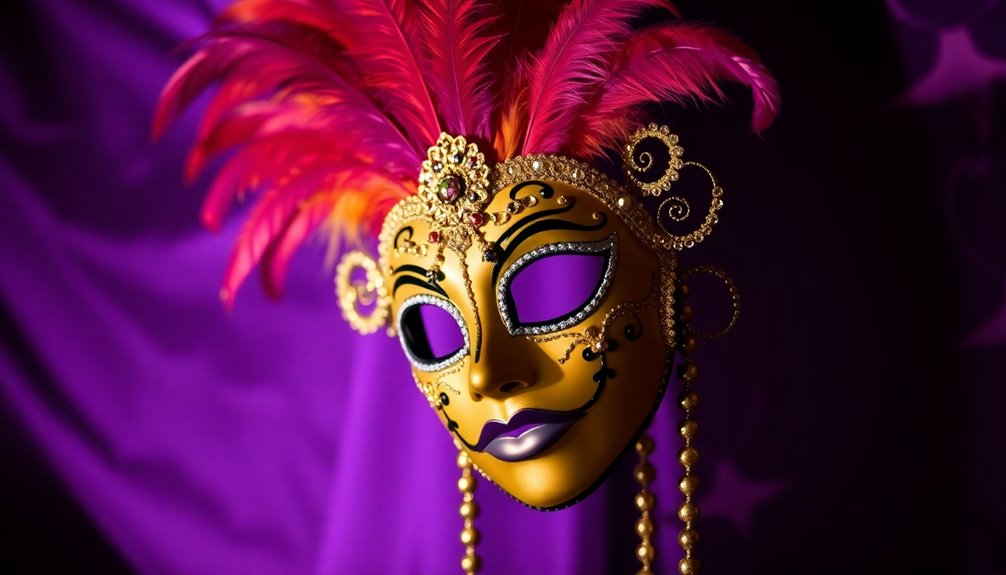
Although you might think of Mardi Gras as a modern celebration, its masks have deep historical roots that trace back to ancient Roman and medieval European festivities.
Originally, Mardi Gras masks were used to conceal identities and encourage social mingling during these lively events. By the 18th century, masks became integral to Mardi Gras celebrations in New Orleans, allowing you to escape societal constraints and engage freely in the festivities.
Over time, the design of Mardi Gras masks evolved from simple animal heads to elaborate creations adorned with feathers, beads, and sequins, showcasing cultural narratives and artistic expression.
Today, Louisiana laws require float riders to wear masks, emphasizing their significance in maintaining tradition and enhancing the festive atmosphere of Mardi Gras.
Cultural Significance of Masks
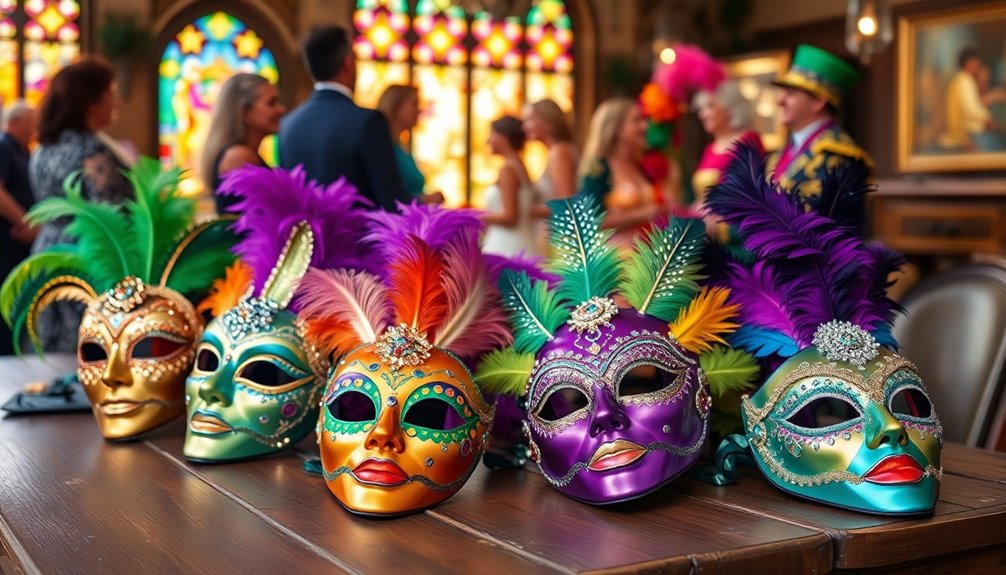
Masks hold a profound cultural significance during Mardi Gras, as they allow wearers to embrace freedom from their everyday identities. When you don a mask during Mardi Gras, you escape societal constraints, fostering an atmosphere of social mixing and inclusivity.
Historically, these masks provided anonymity, enabling marginalized groups to join in the festivities, creating a sense of community. Over the centuries, the artistry of masks has evolved, becoming a significant expression of the African diasporan aesthetic.
Additionally, regulations requiring float riders to wear masks during parades highlight their role in preserving tradition and enhancing the festive spirit.
Ultimately, masks during Mardi Gras serve as powerful symbols of liberation, creativity, and cultural heritage, inviting everyone to participate in the celebration.
Symbolic Meanings of Colors
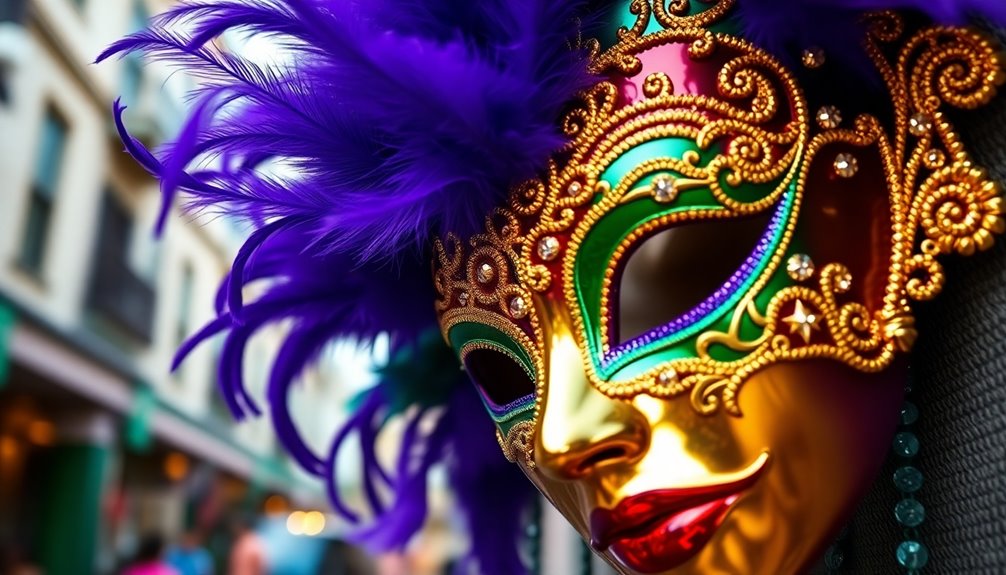
During Mardi Gras, the vibrant colors of masks play an essential role in conveying symbolic meanings that enhance the celebratory atmosphere. Each color represents distinct values, shaping your experience of the festivities:
- Purple: Symbolizes justice, evoking feelings of dignity and respect among participants.
- Green: Represents faith, promoting tranquility and balance, which can resonate deeply during the celebrations.
- Gold: Signifies power, inspiring aspiration and ambition, adding to the festive spirit.
These masks, with their rich colors, not only reflect cultural heritage but also foster community bonding and shared experiences.
Masks and Identity Transformation
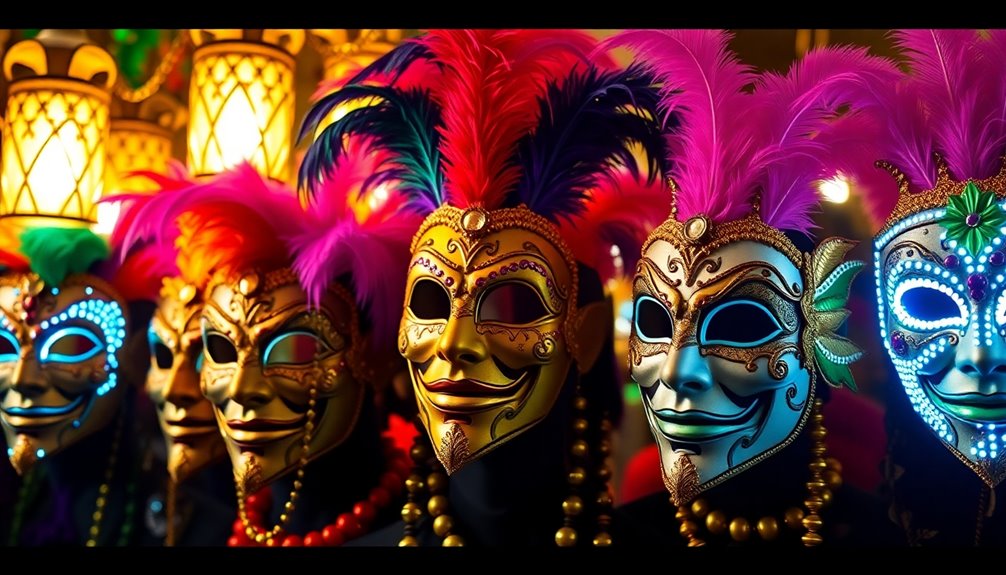
At Mardi Gras, donning a mask transforms your experience, allowing you to embrace a new identity while shedding societal expectations.
Masks serve as powerful tools for identity transformation, granting you the freedom to adopt new personas and escape the daily grind. Historically, they've promoted social mixing, breaking down barriers between classes and encouraging everyone to join in the festivities.
The vibrant colors and elaborate designs of these masks highlight individuality while fostering a sense of community. Furthermore, they symbolize resistance against social hierarchies, enabling marginalized groups to fully express themselves.
In this way, masks at Mardi Gras aren't just decorations; they're essential to the liberation and celebration of diverse identities, enriching the cultural tapestry of the event.
The Role of Masks in Celebrations
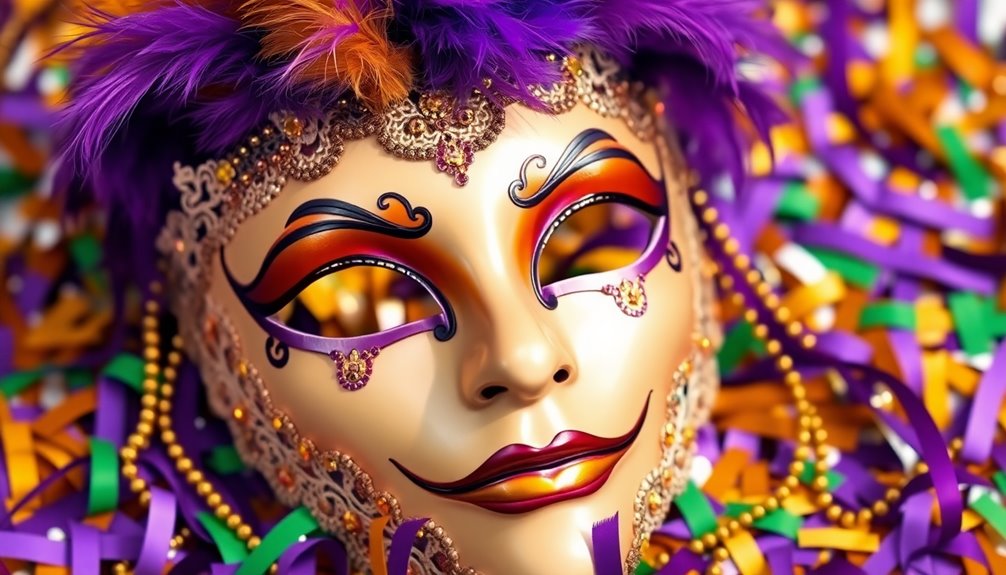
Donning a mask not only transforms your identity but also plays a pivotal role in the overall celebration of Mardi Gras. Masks are essential for float riders and enrich the festive atmosphere. They enable you to blend into the crowd, enhancing your freedom and anonymity during the festivities.
Here's how masks contribute to the celebration:
- Symbolism: The vibrant colors—purple for justice, green for faith, and gold for power—add deeper meaning to your experience.
- Social Mixing: Masks allow people from different classes to interact, breaking down societal barriers.
- Commercial Variety: The thriving market offers an array of mask designs, reflecting both tradition and modern artistry, making your selection unique.
Embrace the masks, and enjoy the celebration!
Economic Impact of Mask Production
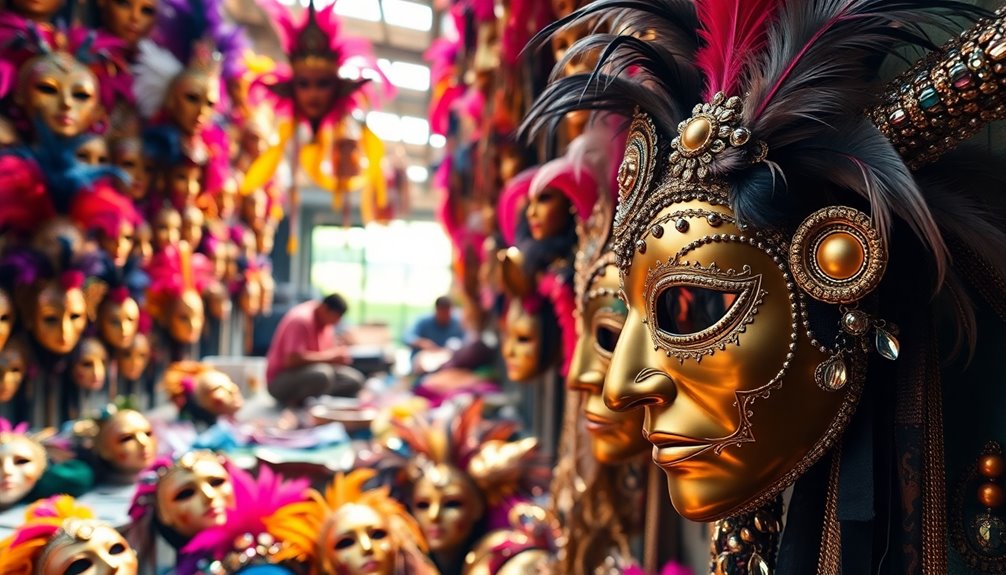
When you think about Mardi Gras masks, consider how they not only express creativity but also fuel the local economy.
Local artisans craft unique designs that attract tourists, driving revenue for shops and the hospitality industry.
This vibrant market not only showcases talent but also creates jobs as the Carnival season approaches. Additionally, the production of these masks can draw parallels to the craftsmanship seen in Indonesian art decor, highlighting the importance of supporting local artisans and preserving cultural heritage.
Local Artisans' Contribution
Mardi Gras masks are more than festive accessories; they're an essential part of New Orleans' economy. Local artisans contribute greatly to mask production, creating jobs and generating income, especially in the French Quarter. Their unique, handcrafted masks not only showcase creativity but also promote cultural heritage and environmental awareness.
Here's how they impact the local economy:
- Job Creation: Mask production provides employment opportunities for many artisans.
- Income Generation: The market for these masks brings in millions annually, benefiting local businesses.
- Community Collaboration: Artisans often work together, sharing resources and strengthening community ties.
This vibrant arts community thrives on the demand for elaborate masks, ensuring that Mardi Gras remains a culturally rich and economically crucial celebration.
Tourism Revenue Generation
While revelers immerse themselves in the vibrant festivities of Mardi Gras, the economic impact of mask production becomes increasingly evident. The celebration generates around $1 billion in tourism revenue annually, with masks playing a key role in attracting visitors. Local businesses, like Maskarade, produce thousands of masks each year, from affordable to extravagant handcrafted pieces.
| Type of Mask | Price Range | Economic Impact |
|---|---|---|
| Affordable Masks | $10-$50 | Accessible for tourists |
| Handcrafted Masks | $100-$500 | Supports local artisans |
| Specialty Designs | $500+ | High-end tourism market |
This commercialization has created jobs and bolstered the local economy, especially during events like the New Orleans Jazz & Heritage Festival, showcasing masks as both art and commercial products.
Modern Trends in Mask Design
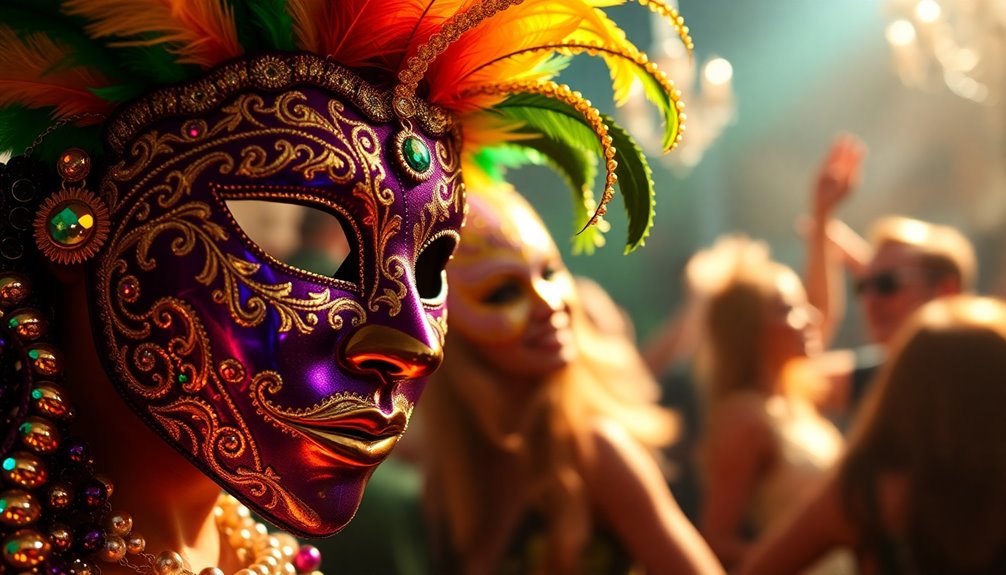
There's no denying that modern trends in mask design for Mardi Gras have transformed the way people express their creativity during the celebration.
With vibrant innovations, masks now reflect a mix of tradition and contemporary flair. Here are some key trends you might notice:
- Innovative Designs: Masks feature intricate patterns and embellishments that attract a diverse audience.
- Eco-Friendly Materials: Many artisans are focusing on sustainability, using materials that are both beautiful and environmentally conscious.
- Social Media Influence: Platforms showcase popular designs, boosting visibility for unique artistic expressions.
These trends not only enrich the festive atmosphere but also enhance community engagement, making every mask a personal statement during Mardi Gras.
Spirituality and Rituals in Masking
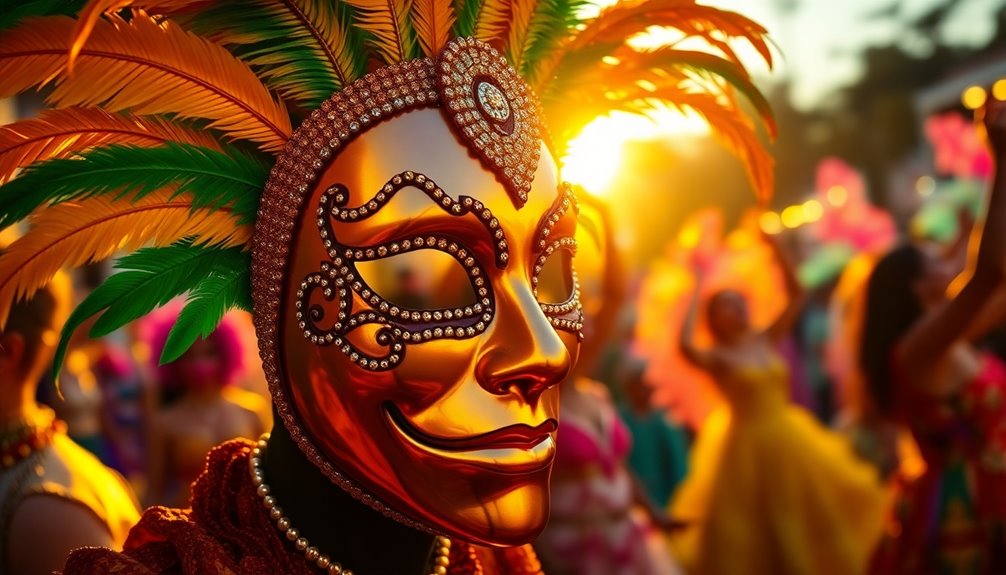
When you don a mask during Mardi Gras, you're stepping into a rich tapestry of spirituality and ritual that honors ancestral spirits and connects with deeper cultural roots. Each mask serves as a powerful symbol, linking the celebration to Louisiana Voodoo beliefs and reflecting a blend of African, Caribbean, and Indigenous practices.
By embodying different identities, you can connect with spiritual dimensions, especially during significant rituals like jazz funerals, where masks facilitate the shift of spirits. Unique symbols on Mardi Gras Indian masks, known only to initiates, underscore their spiritual significance. Furthermore, these practices can evoke strong emotions and memories, similar to dreams of deceased loved ones, highlighting the profound impact of cultural rituals on personal healing.
Participating in the Calinda dance, often performed with masked dancers, further emphasizes the essential role of masks in community healing and cultural expression during these vibrant celebrations.
Community Engagement Through Masks
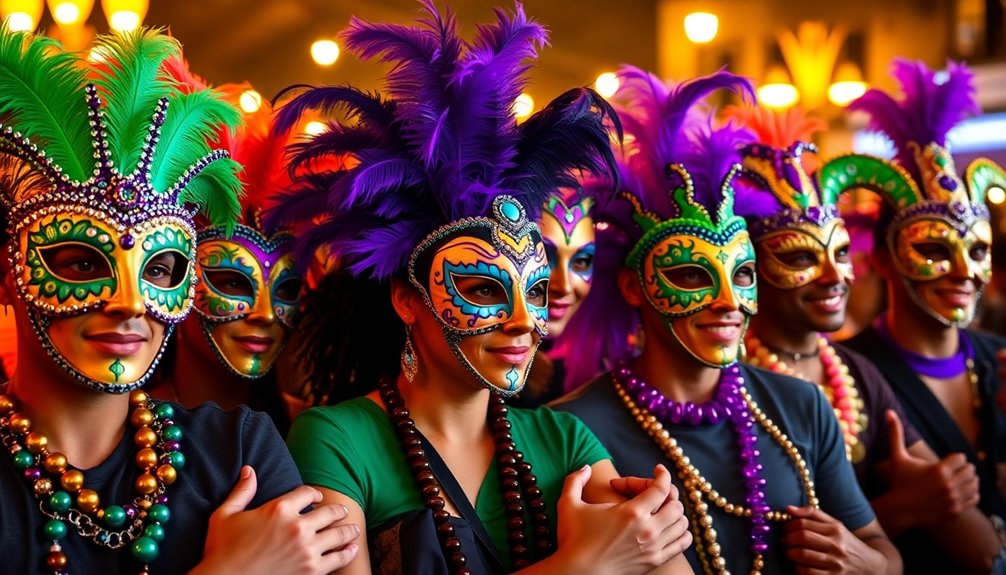
Masks bring everyone together during Mardi Gras, creating a unique sense of unity.
You'll notice how they enhance social interactions, inviting conversations among people from different backgrounds.
Plus, they offer a fantastic way to express your creativity and celebrate local culture.
Masks and Unity
As you immerse yourself in the vibrant festivities of Mardi Gras, you'll quickly notice how masks create a unique sense of unity among participants.
These colorful creations allow everyone to blend into the crowd, breaking down social barriers and fostering connections.
Here are three ways masks promote unity:
- Anonymity: Wearing masks enables social mixing, encouraging interaction across different social classes.
- Alternate Identities: Masks allow you to adopt new personas, helping you engage more freely with others.
- Cultural Expression: The variety of masks showcases the community's creativity and collective heritage.
Community programs further enhance this unity by supporting local artists through mask-making workshops, reinforcing your sense of belonging in these cherished traditions.
Additionally, just as mindfulness techniques can enhance present-moment awareness, masks encourage participants to fully engage in the festivities, heightening their overall experience.
Together, masks embody the spirit of unity at Mardi Gras.
Social Interaction Enhancement
The vibrant atmosphere of Mardi Gras wouldn't be complete without the lively interaction that masks inspire among participants. Masks allow you to blend into the crowd, creating a sense of community and encouraging social interaction across diverse groups.
This tradition helps break down barriers between social classes, fostering an inclusive environment during the festivities. Legal requirements for float riders and attendees to wear masks further emphasize their role in unifying the celebration.
The bright colors and intricate designs of these masks not only attract tourists but also boost local pride and the economy. Additionally, social media keeps community members informed, enhancing connections and participation in Mardi Gras events, making every masked face a part of a larger, joyful tapestry. Special events like themed breakfasts can further enhance community engagement and participation during such celebrations.
Cultural Expression Opportunities
Wearing a mask during Mardi Gras opens up a world of cultural expression and community engagement. Masks allow you to embrace new identities and connect with people from all walks of life. This festive tradition encourages inclusivity and unity, enhancing the vibrant atmosphere of the celebration.
Here are a few ways masks foster community engagement:
- Anonymity: Masks break down social barriers, allowing for free interactions.
- Creativity: The unique designs and colors reflect personal artistry and cultural heritage.
- Economic Impact: Local businesses benefit from mask production, fostering pride and cultural continuity.
As you don your mask, you're not just participating in a tradition; you're contributing to a shared experience that celebrates community spirit and cultural richness.
Frequently Asked Questions
What Does the Mardi Gras Mask Symbolize?
When you wear a Mardi Gras mask, it symbolizes anonymity and freedom. It lets you escape societal constraints and fully immerse yourself in the lively celebration.
The vibrant colors—purple, green, and gold—each carry their own meanings, enhancing the festive atmosphere. Masks also foster social mixing, allowing everyone to participate without revealing their identities.
What Does the Mask Symbolize in Carnaval?
In Carnaval, the mask symbolizes anonymity and freedom, letting you escape everyday constraints and embrace celebration.
When you wear a mask, you transcend social hierarchies, mingling with others in a joyous atmosphere.
The vibrant colors and intricate designs reflect cultural stories, connecting you to the community's spirit.
This tradition encourages inclusivity, inviting diverse individuals to join together, celebrating life, and honoring both sacred and festive elements of the occasion.
What Is the Origin of the Mardi Gras Mask?
You might think masks at Mardi Gras just popped up for fun, but they actually trace back to ancient Roman and medieval celebrations.
Back then, they helped disguise identities and encouraged mingling. When French settlers brought this tradition to New Orleans in the 18th century, it evolved into something vibrant.
What Does the Mask Symbolize?
The mask symbolizes freedom and anonymity, letting you escape societal norms during the festivities.
When you wear a mask, you blend identities and social classes, embracing the joyous spirit of Mardi Gras. The vibrant colors—purple, green, and gold—represent justice, faith, and power, adding depth to your celebration.
Historically, masks allowed marginalized groups to join in without fear, fostering inclusivity and community engagement, making them an essential part of the cultural heritage.
Conclusion
As you don a Mardi Gras mask, think of it as a key that opens up a world of freedom and creativity. Just like the vibrant colors and intricate designs tell stories of heritage, your mask allows you to step outside your everyday self. In 2023, over a million masks were sold in New Orleans alone, each one a symbol of transformation and celebration. So, embrace your mask; it's not just an accessory, but a gateway to community and joy.









